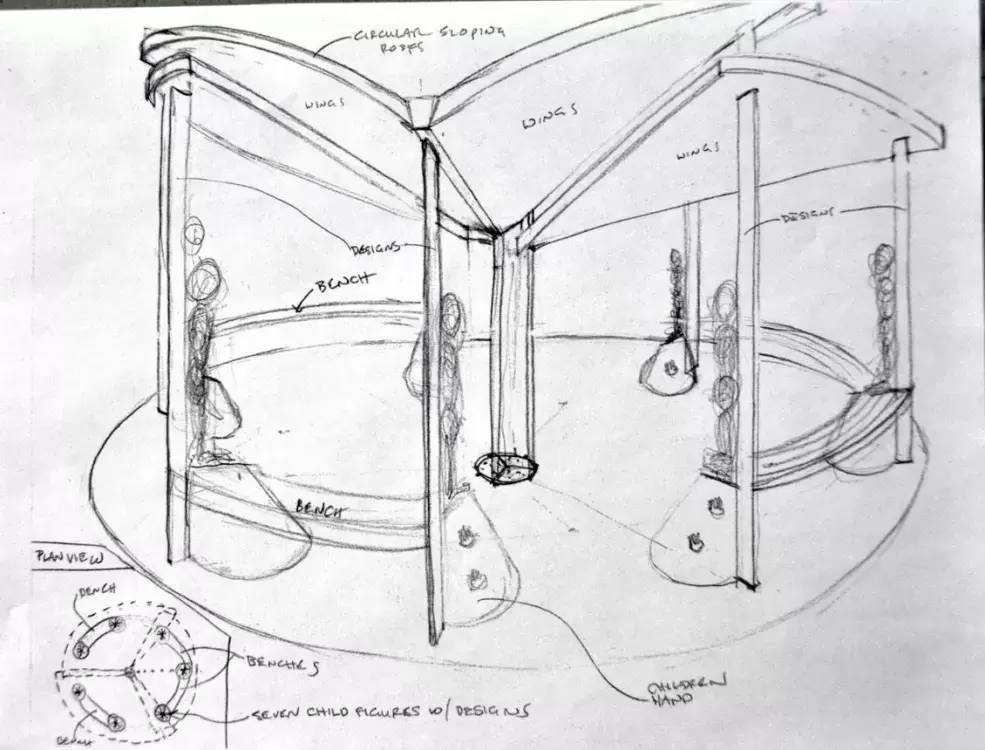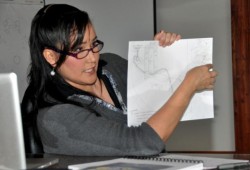A design has now been selected for the commemorative sculpture and park to honour survivors of the Alberni Indian Residential School.
The project, which is funded by a government grant acquired by Tseshaht First Nation, will be located between the health office and the longhouse at the Tseshaht/Nuu-chah-nulth Tribal Council administration complex, just metres from where the school building once stood.
On Feb. 16, the small gathering of survivors who attended a meeting in the Tseshaht Great Room settled on a roofed circular setting with multiple child figures over an undulating pathway leading through a portal to a single child sculpture.
Studying the design, which contains seating, survivor Anita Schievink searched for an appropriate descriptive term.
“So it’s gazebo-ish?” she asked designer and project manager Connie Watts, who nodded in agreement.
In the concept drawing, the site has a central pole with seven outer poles supporting a multi-winged roof designed to collect and channel away tears–or rain, said Watts. The poles will have child figures on them and the plan is to have children incorporate their handprints into the surfaces.
The poles would also bear the names of survivors and, perhaps, designs reflecting the image of the school building itself or even artifacts from the school.
But while there was agreement that both designs were pleasing, the survivors who attended questioned whether the project itself is appropriate. Gloria Ross reminded the artist of what the project is commemorating.
“My parents went to residential school. I went to residential school,” Ross said. “The children thought their parents were giving them up, but they were stolen. They were taught foreign ways. There were some [staff], I am told, who were compassionate; I never saw any. The children learned bullying there. My uncle said they buried some children there. This is supposed to be a positive thing. Are we saying we are going to forget them?”
Dolly McRae suggested incorporating beauty into a project memorializing an ugly episode in human history is self-defeating.
“It’s hard to go to something really beautiful and be able to imagine what it was really like. We were in a really cold ugly place,” she said. “Everything was by time: the bell rang, you got up and went downstairs to line up to eat. You were lining up everywhere. And I did that for 10 years.”
McRae said globally, horror memorials tend to be stark reminders of the events that took place.
“If I went to Auschwitz, I would see it and I would feel the people and I would ask, ‘How did this happen?’ I would want people to have the same response, to make them want to ask questions,” McRae said.
George Clutesi Jr. said he had a number of misgivings, beginning with: once the project is built, who is going to maintain it? Clutesi said there are any number of funded projects that, once completed, are left to deteriorate. He also questioned whether it was appropriate to locate it in the proposed site.
“It’s where it happened,” Watts said.
Clutesi said he was very affected by the demolition of the old Peake Hall dormitory in February 2009, which was attended by survivors from around the province. In light of the experience, creating a permanent memorial carries heavy responsibilities, he suggested.
“I recall a little old lady who picked up a sledgehammer and swung it harder than I could have. You could see the emotion. A lot of people came from a long, long way away and you could see the tears as they came up the hill.”
Talking to those people, Clutesi said, he realized the fact that the school was located on Tseshaht land still weighed heavily in the minds of survivors who had been torn from their families and their traditional territories. That makes creating a suitable memorial a very complex, and possibly unattainable goal, he said.
See story about the dormitory demolition: http://www.hashilthsa.com/archive/news/2012-11-13/tseshaht-hosts-survivors-demolition-peake-hall
Calling it the “most meaningful project she has ever been involved in,” Watts said the designs incorporated into the project would accomplish the goal of summoning up history without resorting to literal or clinical images.
“These are objects. They’re not pretty – they’re showing what it is,” she said.
Watts said using West Coast First Nations designs is not “prettifying” history. The imagery was used up and down the B.C. Coast, from where most of the students were drawn.
“These are who we are,” Watts said. “You don’t slam people’s faces into it; you bring them in.
“The goal is to bring people into a protected space… a safe place to come, reflect, let go and reclaim their lives.”
The matter of incorporating the names of children who attended the school proved contentious, raising issues of privacy. The survivors did provide a number of suggestions for the final design itself, including the addition of an entryway. Ross strongly suggested, to general agreement, that along with the images of the children who attended, there should also be images of their grieving parents.
Watts warned not to expect literal imagery. The challenge, as an artist, she explained, is to absorb all of the conflicting images, memories and emotions from survivors and their families, then abstract it into designs that spark the desired response from all who visit.
“That’s why a place to go to and to contemplate kept coming back to me,” she said.
There isn’t a great deal of time to bring the project to completion, Watts said after the meeting. Saturday’s session followed a similar meeting in January, which resulted in the two design concepts as brought forward by Connie Watts, but it was Ken Watts who actually secured the grant funding and proposed the physical parameters of the project, she explained.
“We have a deadline of March 31 to have the installation in place,” Watts said, adding that the decorative components like sculptures would be added as they are completed, but the basic building would be finished quickly.
The project has a tight budget and Tseshaht is looking for sponsors to assist in bringing it to completion. Anyone seeking to provide financial or material assistance is asked to contact Lisa Gallic at lgallic@teseshaht.comor Nicole Watts at projects@tseshaht.com.
Related:
http://www.hashilthsa.com/news/2013-02-14/residential-school-art-be-reunited-survivors
http://www.hashilthsa.com/gallery/art-work-children-alberni-indian-residential-school









